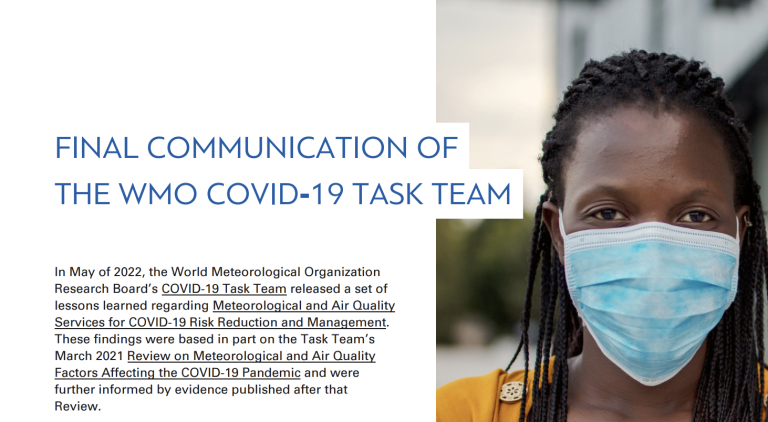WMO updates findings on role of meteorology and air quality in COVID-19 transmission

The World Meteorological Organization’s COVID-19 Task Team has issued its final report, confirming and updating its findings that meteorology and air quality played a secondary role on disease transmission.
Lessons learned from the pandemic showed how environmental data can and cannot be used when predicting the spread of a respiratory virus. It is therefore critical that researchers continue to study the role of meteorological and air quality factors in COVID-19, given the potential to use such knowledge to prepare for and respond to future international health emergencies.
The updated umbrella review was commissioned by the WMO Research Board’s COVID-19 Task Team and it updates findings released in May 2022 regarding Meteorological and Air Quality (MAQ) Services for COVID-19 Risk Reduction and Management.
The main findings include the following:
- Studies from the first two and a half years of the COVID-19 pandemic indicate that the influence of meteorology and air quality on disease transmission have been secondary compared to the influence of non-pharmaceutical interventions, vaccination campaigns, changing immunity profiles, introduction of variants, and behavioural dynamics.
- There has been no evidence that certain weather conditions (e.g., warm and humid conditions) absolutely precludes transmission, as had been suggested by some commentators early in the pandemic.
- Overall, the literature provided evidence for possible associations between temperature and humidity and COVID-19 incidence, and poor air quality and severe COVID-19 outcomes. The findings suggest that associations between weather and COVID-19 incidence (via impacts on transmission) and severe outcomes are complex and likely non-linear.
- Several analyses consolidated in this review suggest an association between exposure to pollutants affecting air quality and severe COVID-19 outcomes. However, further studies are needed on this.
- Process-based modelling studies anticipate that COVID-19 transmission may become seasonal over time, suggesting MAQ factors may support monitoring and forecasting of COVID-19. This expectation is consistent with knowledge of many other respiratory viral infections, particularly in temperate climates. Continued data collection and analysis will be critical for risk assessment and communication as COVID-19 transitions from epidemic to endemic dynamics.
- While meteorology and air quality factors may have been secondary to other influences in the first years of the pandemic, it must be noted that the number of infections and deaths from COVID-19 was very large, such that even secondary factors can have large total impact. For this reason, it is critical that researchers continue to study the role of MAQ factors in COVID-19 and the potential to apply such knowledge to pandemic preparedness and response.
- Similarly, as a new globally endemic disease, COVID-19 retains the possibility of causing severe outcomes. Even small percentage changes in COVID-19 incidence and severity will result in large impacts in terms of cases and deaths. Consequently, understanding the role of MAQ in transmission and outcomes of infection remains an important research endeavor to allow development of accurate forecasting and effective interventions.
- MAQ information has also proven to be useful in COVID-19 preparedness and response beyond the specific question of transmission sensitivities. For example, meteorological forecasts that inform preparedness for extreme storms, heat events, and other hazards have supported actions to mitigate the impacts of those events in a manner that is consistent with COVID-19 precautions. We encourage the National Meteorological Services and the meteorological academic community to closely collaborate with health experts in order to further incorporate MAQ into COVID-19-related services, products and activities.
“Efforts from around the world to understand meteorology and air quality impacts on SARS-CoV-2 transmission and COVID-19 severity have yielded new approaches to data, new cross-disciplinary collaborations, and a broad appreciation of how difficult it is to disentangle risk factors during an ongoing pandemic,“ said Task Team chair, Dr Ben Zaitchik, Department of Earth & Planetary Sciences, Johns Hopkins University, Baltimore, USA.
“The specific findings of these studies are complex and will continue to be examined in coming years. Notwithstanding the nuance of those results, it is clear that researchers and the public have learned a tremendous amount about how environmental data can and cannot be used when predicting the spread of a respiratory virus,” said Dr Zaitchik.


